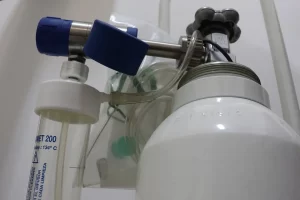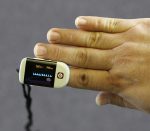
Thinking about becoming a respiratory therapist?
You will need a top-notch training program to make it work.
But with online learning becoming more widespread these days, you might be wondering if you can train as a respiratory therapist from home.
This article will tell you everything you need to know about online respiratory therapist training programs and if they’re a good choice for you.
Page Navigation
- What Courses Are in an Online Respiratory Therapist Training Program?
- Can You Earn a Respiratory Therapist Certification Completely Online?
- How Long Does it Take to Earn a Respiratory Therapist Certification Online?
- How Much Does an Online Respiratory Therapist Certification Cost?
- Benefits of Online Respiratory Therapist Training Programs
- Drawbacks of Online Respiratory Therapist Training Programs
- Benefits and Drawbacks of Online Respiratory Therapist Training Programs – Summary Table
- Types of Respiratory Therapist Certifications
- 4 Self-Study Tips for Online Respiratory Therapist Students
- Summary
- Frequently Asked Questions
What Courses Are in an Online Respiratory Therapist Training Program?
Most respiratory therapist training programs include a variety of both general and specific medical courses.
These are designed to give students a solid introduction to the medical field, then provide specific education in respiratory care practices and techniques.
They will also learn about pulmonary diseases and emergency care.
Other courses might include:
- Pediatric specialty care
- Pharmacology
- Pulmonary diseases
- Respiratory care theory
- Managing medical equipment such as life support systems
- Breathing therapies
- Plan management
- Patient assessment
- Therapeutic care
- Emergency care
Can You Earn a Respiratory Therapist Certification Completely Online?
While it varies between institutions, many schools now offer the option to earn a respiratory therapy certification online.
These programs take place completely online when it comes to class lectures and exams.
The caveat with these programs comes with the practical side of things.
Getting your respiratory therapist certification requires some hands-on experience, which cannot be completed virtually.
To get familiar with respiratory therapies and equipment in a real-life setting, you will need to take part in an internship.
Most online respiratory therapist certification programs include virtual class lectures and in-person work studies.
How Long Does it Take to Earn a Respiratory Therapist Certification Online?
The amount of time it takes to earn a respiratory therapist certification online can vary from program to program.
Most programs take about two years from start to finish.
They usually involve getting an associate’s degree in respiratory therapy, then passing the RRT exam, earning your certification, and at last getting your license.
If you decide to get a bachelor’s degree or if you need to take the exam multiple times, it may take you longer to get your certification.
How Much Does an Online Respiratory Therapist Certification Cost?
Getting your respiratory therapist certification online requires getting an associate’s degree, so it is roughly comparable to other online college programs in that regard.
There are other costs associated with becoming certified and licensed, and these may vary from state to state.
Costs also depend on the type of exam and certification you are pursuing.
There are several types of respiratory therapist certifications, so the numbers can vary significantly from test to test.
In general, however, you can expect to pay for the following:
- Initial exam – Between $150 and $300 depending on the type of certification
- Retakes – Between $150 and $250
- Certification renewals – $25 annually for five years
- Licensure application – $300
Benefits of Online Respiratory Therapist Training Programs
The benefits of online respiratory therapist training programs are very similar to other remote study programs.
These benefits are only some of the reasons why virtual learning is becoming more and more common.
1. Flexible scheduling
One of the biggest pros of studying online is flexible scheduling.
Many students enjoy being able to access their coursework and lectures at whatever time is most convenient for them, especially if the course uses pre-recorded lectures.
This makes it possible for students to work, care for children, and do other tasks throughout the day.
2. Flexible pacing
Studying respiratory therapy remotely also means that you can set your own pace for learning.
Professors often keep lectures, notes, and study resources available in a virtual classroom, which means that students can go back and access them in their personal time.
3. Communication
Studying in a virtual environment often streamlines communication, making it easier to contact your professor and peers when you need to.
Many online training programs now take place in an all-in-one virtual classroom, where you can access study materials, listen to lectures, and communicate.
4. Access to Resources
When your classroom is online, you are already at the best starting point to access all the learning materials you could ever need.
Online classes make it possible to learn not only the coursework but also from your classmates and through linked resources such as videos and virtual textbooks.
Drawbacks of Online Respiratory Therapist Training Programs
There are not many drawbacks to studying respiratory therapy online.
But like any program, there are pros and cons.
1. May require hybrid virtual and in-person training
Unlike most virtual college programs, respiratory therapy may require an in-person work-study to get your certification.
That is because you need hands-on experience in treating patients, practicing therapies, and using the equipment.
However, this is not necessarily a drawback — some people enjoy having the combination of virtual and in-person learning.
Some programs might provide simulated training to replace in-person work.
2. May not provide the same level of hands-on experience
Some people find it frustrating that virtual studies don’t offer the same level of in-person, practical experience.
This might especially be the case for students whose programs utilize simulated training.
For people in highly practical careers like respiratory therapy, there may be a sense of having missed out on important lessons and experiences in a classroom setting.
3. Isolation
Some people find it difficult to study effectively in an environment of isolation.
It can be especially hard to stay motivated without effective support in a classroom setting.
To combat this, it may be helpful to form study groups that meet in-person to compare notes and help prepare for important exams.
4. Disorganization
Some students struggle to stay organized when their home is both their classroom and their study space.
This can lead to procrastination and poor exam preparation.
It is up to each student to find ways to organize their studies and stay motivated even while learning at home.
People studying remotely need to develop excellent time management skills and adapt to the challenges of a virtual classroom.
5. Communication
Communication falls into both pro and con categories when it comes to virtual learning.
While studying from home offers unique ways of communicating with your professors and peers, it can also present challenges.
This is especially true if the technology used has a steep learning curve, making it difficult to operate.
Benefits and Drawbacks of Online Respiratory Therapist Training Programs – Summary Table
| Benefits of Online Respiratory Therapist Training Programs | Drawbacks of Online Respiratory Therapist Training Programs |
|---|---|
| 1. Flexible scheduling | 1. May require hybrid virtual and in-person training |
| 2. Flexible pacing | 2. May not provide the same level of hands-on experience |
| 3. Communication | 3. Isolation |
| 4. Access to Resources | 4. Disorganization |
| 5. Communication |
Types of Respiratory Therapist Certifications
There are many types of respiratory therapists, so it should come as no surprise that there are a variety of certifications and exams.
These vary in difficulty, program requirements, and responsibilities.
Types of respiratory therapist certifications include:
- Certified respiratory therapist (CRT)
- Registered respiratory therapist (RRT)
- Certified pulmonary function technologist (CPFT)
- Registered pulmonary function technologist (RPFT)
- Adult critical care specialist (ACCS)
- Neonatal/pediatric specialist (NPS)
- Sleep disorders specialist (SDS)
4 Self-Study Tips for Online Respiratory Therapist Students
Studying respiratory therapy can be intense, and it is easy to feel overwhelmed — especially if you are trying to get your certification from home.
Here are a few tips to help you while you are earning your respiratory therapist certification online.
Keep Your Study Space Organized
When you are studying at home, it can be tempting to let your home life encroach on your classroom life.
To avoid getting overwhelmed and to make your studying more effective, keep a dedicated space that is just for studying.
This might be your desk or even your kitchen table.
No matter where it is in your home, make sure you have all your classroom needs set up in one place.
That means making sure that all your study materials are organized and within easy reach.
Take plenty of notes and keep them as tidy as possible so you can refer back to them when you are studying.
Reach Out to Your Classmates
Just because you are not in a physical classroom with your peers doesn’t mean that you cannot communicate.
Reach out to your classmates for resources, tutoring, or group studying.
You can even do these activities virtually, with everyone “meeting” from their computer.
While it might not be the exact same experience that you’re used to, it can still be helpful and productive, especially in a difficult training program like respiratory therapy.
Develop a Personal Study Style
If flashcards are not your jam, you are not alone.
Everyone studies differently, and you may find one method more effective than others!
It all comes down to finding the right study method for you.
Maybe you learn best by listening.
Maybe you are a visual learner who retains information from videos and live demonstrations.
Or maybe you have a very particular note system that helps information stick in your brain.
Ultimately, there is no right answer.
It is all about doing trial and error until you land on the most effective method for you.
Take Notes
It seems like a basic tip, but taking notes — detailed ones — is extremely important.
This also goes for classes that are online, even if they are prerecorded lectures that you can listen to multiple times.
It is always best to create an organized set of notes that you can skim easily to recap the most important points of a lecture.
This, too, can take some trial and error to figure out what note-taking method works best for you, especially when it comes to studying online.
One great strategy for effective note-taking is to rewrite your notes.
This helps reprogram the key information in your brain all over again.
Just make sure you write by hand!
Summary
Becoming a respiratory therapist is a challenge, and studying online for a program like this has many pros and cons.
However, it can be done — it just requires a great online program as well as self-discipline and organization.
If you are balancing other responsibilities or work, an online respiratory therapist training program may be a great choice for you.
Frequently Asked Questions
What Skills Does a Respiratory Therapist Need?
A respiratory therapist works with both patients and medical providers, which means they need a combination of practical skills and “soft” skills.
Practical skills involve administering medications, developing patient care plans, consulting with other medical professionals, practicing respiratory therapies, and using medical equipment.
Soft skills, on the other hand, involve knowing how to communicate with patients, compassion, patience, and problem-solving.
Respiratory therapists also need to be:
- Organized
- Detail-oriented
- Communicative
What Education is Required to Become a Respiratory Therapist?
Most respiratory therapist training programs require an associate’s degree at a minimum.
However, many students are encouraged to get their bachelor’s degree before starting a respiratory therapist training program, as this may help them stand out to potential future employers.
What is the Passing Score for RRT?
The RRT exam is famously one of the most difficult medical exams, and it requires extensive studying and preparation in order to pass.
It involves two sections — 160 multiple-choice questions and a four-hour simulated clinical setting designed to test your knowledge and problem-solving skills.
The first section requires 62.87 percent (88 questions out of 140 scored questions) to qualify for a CRT credential; however, students must achieve at least 67.14 percent (94 questions out of 140) to be able to take the CSE.
How Many Times Can You Take the RRT Exam?
Strictly speaking, there is no limit to the times you can retake an RRT exam.
However, there are some rules surrounding this.
Most respiratory therapist exams may be taken twice, after which there is a mandatory waiting period of 180 days.
This is to ensure that anyone who passes the exam has adequate knowledge and training to provide excellent patient care after receiving their certification.








